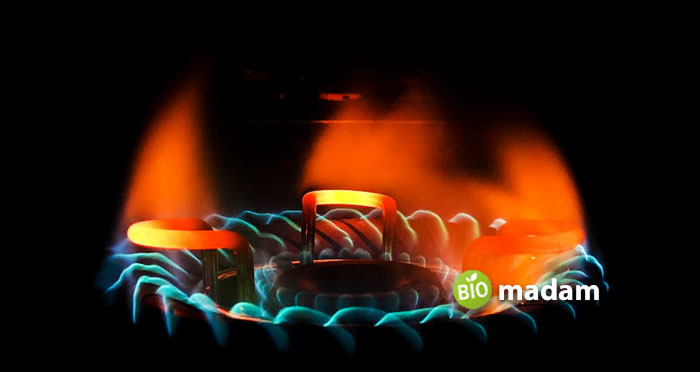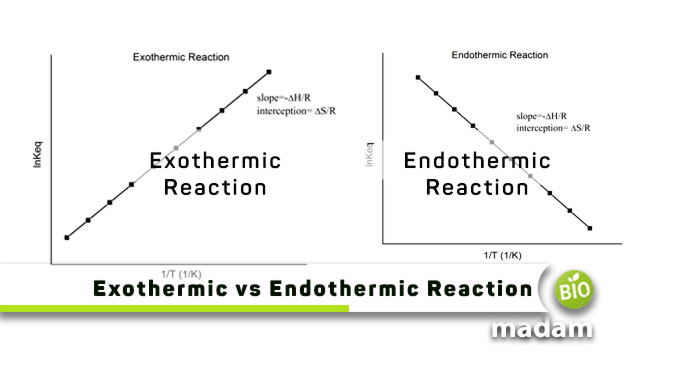Recently updated on March 1st, 2023 at 12:45 pm
Chemical reactions take place all around us, enabling various processes in the biome and ecosystem. Exothermic and endothermic are two primary classes of chemical reactions. They are categorized based on intake or release of heat, for example photosynthesis and cellular respiration. Whenever a chemical reaction takes place, it absorbs or releases energy. That energy can be measured through heat emission or absorption when you know if the process is exothermic or endothermic.
Keep reading to learn all the differences between exothermic and endothermic reactions and their occurrences in the environment.
Comparison Table
| Factors | Exothermic Reaction | Endothermic Reaction |
| Type of Rxn | Energy-releasing reactions | Energy-absorbing reaction |
| Change in Energy | Lower energy | Higher energy |
| Surrounding Temp. | Increases | Decreases |
| Form of Energy | Light, heat or sound | Heat |
| Enthalpy Change | Negative | Positive |
| Entropy Change | Positive | Negative |
| Type of Products | More stable than reactants | Less stable than reactants |
| Examples | Nuclear fission, rusting iron, and neutralization | Photosynthesis, melting ice, and thermal decomposition |
What are Exothermic Reactions?
The word exothermic combines ‘exo,’ meaning release, and ‘thermal,’ meaning heat. Thus, exothermic reactions are chemical changes that release energy. Sometimes the heat or light energy released by exothermic reactions may be negligible. On the other hand, you may feel the heat evidently in other cases.
Reactants → Products + energy
The release of energy during an exothermic reaction is attributed to the formation of new chemical bonds. As the energy for breaking the bonds is lower, the enthalpy changes are also lower at the completion of the reaction. The energy released at the end of the reaction was used by bonds to hold the molecules together. Thus, the reaction between two molecules results in energy release.
Exothermic reactions lower the internal energy by releasing energy. You can find out exothermic reactions by feeling a higher temperature around the working station.
The enthalpy changes in an exothermic reaction are denoted by:
ΔH = H (products) – H (reactants) = A negative value
Examples of Exothermic Reactions
- Fuel combustion
- Neutralization reaction between acid and base
- Dissolution of acid in water
- Nuclear fission

What are Endothermic Reactions?
Opposed to exothermic, endothermic is a fusion of ‘endo’ meaning ‘within’ and ‘thermic’ translating to ‘heat.’ Endothermic reactions absorb energy instead of releasing it. Organic and inorganic endothermic reactions take place by absorbing heat from the surroundings to complete the chemical reaction.
Reactants + Energy → Products
The reaction absorbs energy from the outside, which makes the energy changes in the system positive. The system’s enthalpy is equal to the sum of enthalpies of the reactants in the beginning. Towards the end of the natural or lab experiment, the enthalpy of the product formed is higher due to the energy absorbed from the surroundings. The enthalpy change during the process can be expressed through this equation:
ΔH = H (products) – H (reactants) = A positive value
Examples of Endothermic Reactions
- Photosynthesis
- Melting ice
- Thermal decomposition
- Dissolution of ammonium chloride in water

Difference Between Exothermic and Endothermic Reactions
Literal Meaning
Exothermic Reactions
The word exothermic forms from ‘exo,’ meaning release, and ‘thermic,’ meaning heat.
Endothermic Reactions
Similarly, endothermic combines ‘endo,’ meaning absorb, and ‘thermic,’ translating to heat.
Definition
Exothermic Reactions
Exothermic reactions are chemical reactions that release energy in the form of heat or light.
Endothermic Reactions
Opposed to exothermic reactions, endothermic reactions absorb energy from their surroundings during the chemical reaction.
Equation
Exothermic Reactions
Exothermic reactions are denoted by: Reactants → Products + energy
Endothermic Reactions
Conversely, endothermic reactions are expressed by the equation: Reactants + Energy → Products
Energy Change
Exothermic Reactions
Energy is lost during exothermic reactions in the form of heat or light as studied in different branches of chemistry.
Endothermic Reactions
Alternatively, endothermic reactions have higher energy at the end resulting from energy absorption.
Form of Energy
Exothermic Reactions
Exothermic reactions may release energy in the form of light, heat, or sound energy.
Endothermic Reactions
On the contrary, endothermic reactions absorb heat from the surrounding in applied chemistry and other occurrences.
Enthalpy Change
Exothermic Reactions
The enthalpy change in an exothermic reaction is negative at the end of the reaction due to the release of energy.
Endothermic Reactions
At the same time, endothermic reactions have a positive enthalpy change due to energy absorption during the chemical reaction.
Examples
Exothermic Reactions
Exothermic reactions include rusting iron, nuclear fission, cellular respiration and neutralization reaction between acid and base.
Endothermic Reaction
On the contrary, photosynthesis, melting ice, and thermal decomposition are examples of endothermic reactions.
The Bottom Line
Exothermic and endothermic reactions are the main types of chemical reactions based on the absorption or release of energy. Exothermic reactions release energy in the form of heat, light, or sound. On the other hand, endothermic reactions take place by absorbing energy from the surroundings. The fundamental difference between exothermic and endothermic reactions is the enthalpy change. Exothermic reactions exhibit a negative enthalpy, whereas endothermic reactions show positive change. They are of critical importance in nature and in chemistry, biochemistry and molecular biology.
FAQs
How can you tell the difference between exothermic and endothermic reactions?
The main difference between exothermic and endothermic reactions is the release of energy in the former and absorption of energy in the latter.
How do you tell if a reaction is endothermic or exothermic by looking at the equation?
The chemical equation can help detect if the reaction is exothermic or endothermic by looking at the enthalpy changes. Equations exhibiting a higher enthalpy show an endothermic reaction. Contrarily, a higher sum of reactants than the products shows an exothermic reaction.
How are exothermic or endothermic reactions used in daily life?
Lighting a stove, fuel combustion, corrosion, and transpiration are common exothermic reactions in our daily life. Unlike transpiration, evaporation and melting are everyday endothermic reactions.

Hello, I would like to introduce myself to you! I am Chelsea Rogers, an experienced blog writer for science articles, holding an MPhil degree. My enthusiasm to grab the best knowledge, let it relate to botany, zoology, or any other science branch. Read my articles & let me wait for your words s in the comment section.

